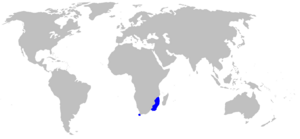White-spotted Izak facts for kids
Quick facts for kids White-spotted Izak |
|
|---|---|
| Conservation status | |
| Scientific classification | |
| Genus: |
Holohalaelurus
|
| Species: |
punctatus
|
 |
|
The white-spotted Izak or African spotted catshark (Holohalaelurus punctatus) is a type of catshark. It belongs to the family called Scyliorhinidae.
You can find this shark in the western Indian Ocean. It lives off the coasts of Natal in South Africa, southern Mozambique, Madagascar, Kenya, and Tanzania. These sharks live in deep waters, usually between 220 and 440 meters down. They can grow up to 35 centimeters long.
Contents
About the African Spotted Catshark
The white-spotted Izak is also known as the African spotted catshark. Its scientific name is Holohalaelurus punctatus. It has two other scientific names that mean the same thing: Holohalaelurus polystigma (named in 1921) and Scylliorhinus punctatus (named in 1914).
This small shark lives along the upper part of the continental slope. This is a deep area of the ocean floor. They are found at depths of 220 to 420 meters. Adult males of this species tend to be larger than females. This is not common among shark species.
What Does It Look Like?
Male African spotted catsharks are usually between 24 and 33 centimeters long. Females are a bit smaller, ranging from 22 to 24 centimeters long. The longest one ever recorded was 34 centimeters.
These sharks have short bodies with special scales called dermal denticles on their backs. They have a wide head and a short snout. Their mouths are large, and the number of teeth can be different between males and females. They also have a long, thin tail.
Where It Lives and What It Eats
The African spotted catshark lives in the upper continental slope. This area stretches from Madagascar, Mozambique, and South Africa in the Western Indian Ocean. They live in deep waters, from 220 to 420 meters down.
These sharks become adults around 9 years old. They can live for about 21 years. Their diet includes small bony fish, crustaceans like crabs and shrimp, and cephalopods like squid. Female sharks lay eggs in pairs. Not much else is known about their reproduction, like how often they lay eggs.
Protecting the African Spotted Catshark
Right now, there are no special groups actively working to protect these sharks. However, there are some Marine Protected Areas (MPAs) in the region where they live. These areas help protect ocean life, which can also help the African spotted catshark.
More information is needed about their population numbers and how many are caught by fishing. Until then, it's hard to start big conservation efforts.
Threats to the Sharks
The biggest danger to the African spotted catshark is deep-water fishing. These fishing boats use large nets called trawls. They operate at depths of 100 to 600 meters, which is exactly where these sharks live.
About 2 to 3 fishing boats work in this area at a time. They fish around 1,000 times a year. We know about these fishing trips, but there isn't good information on what types of fish are caught. Fishing in Madagascar is also increasing, which puts more pressure on ocean life. Pollution in the ocean is also harming their habitat.
See also
- List of sharks


